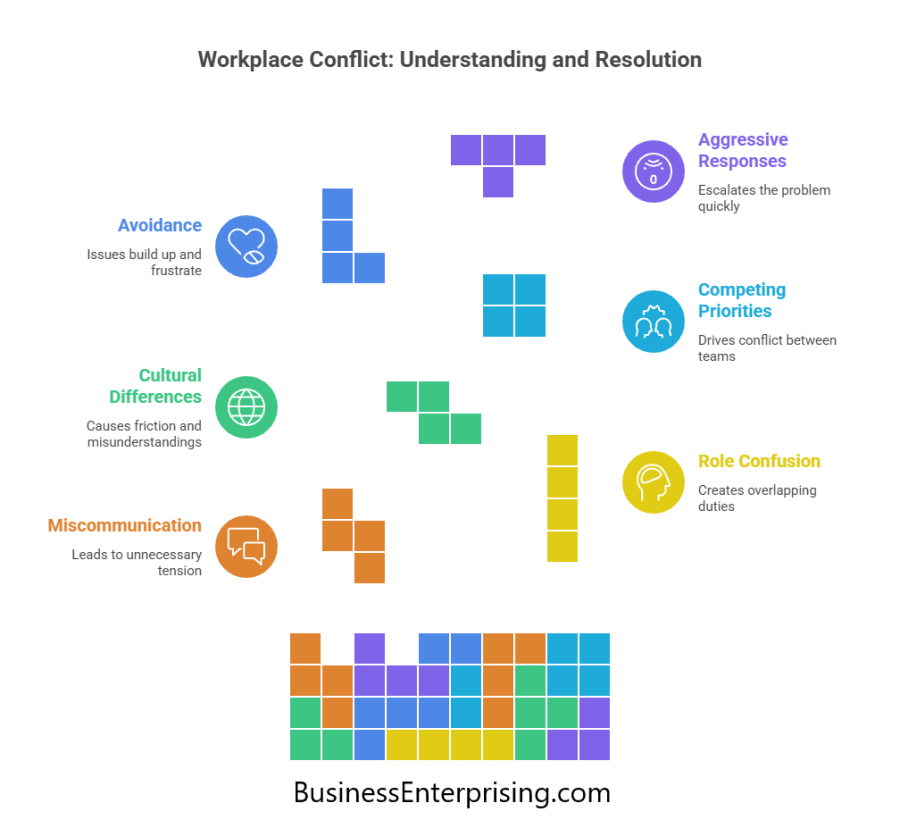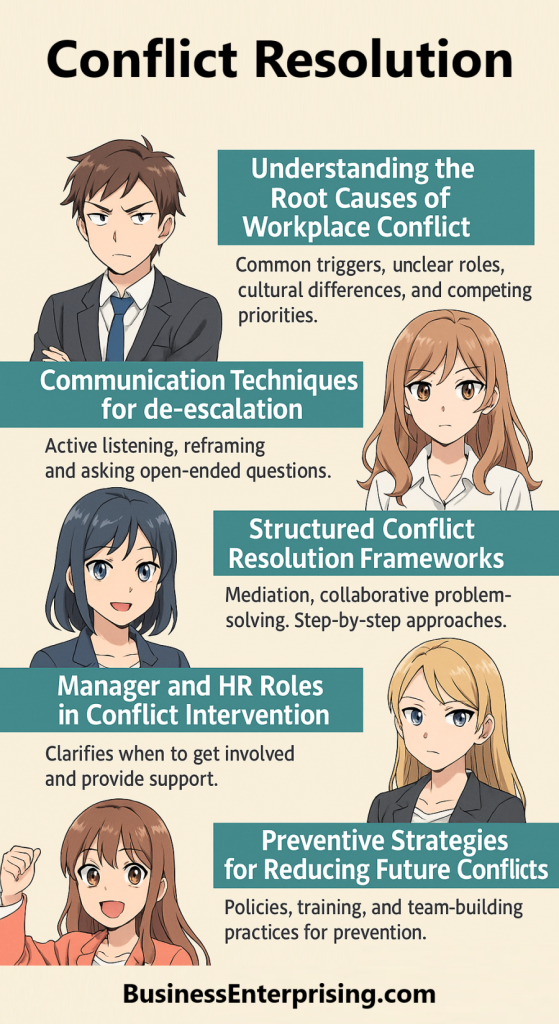
Additionally, most conflict doesn’t start with bad intent. Miscommunication, unclear expectations, or competing goals often cause the friction you see. When teams lack structure or support, tension builds quickly. You can reduce that risk by understanding how conflict develops and how to respond without overreacting.
Managers play a key role in spotting early signs. However, it’s not always their job to fix everything. Sometimes, a simple conversation or a small policy change can reduce future issues. Other times, you may need HR support or a more formal process. Knowing the difference helps you stay consistent and fair.
Furthermore, training and prevention help your team manage conflict better on their own. People learn how to raise concerns, listen well, and work through disagreement. These habits improve your culture and reduce wasted time. Conflict doesn’t need to be negative. If handled well, it can lead to better clarity, stronger communication, and smarter decisions.
You don’t need to control every conversation. However, you do need to lead by example. The more consistent your approach, the more confident your team becomes. With the right tools and habits, conflict becomes a part of progress, not a barrier to it.
Understanding the Root Causes of Workplace Conflict
Workplace conflict often starts with simple misunderstandings that grow over time. Miscommunication is one of the most common root causes. People interpret messages differently based on tone, context, and personal expectations. Therefore, unclear language or assumptions can quickly lead to tension between coworkers.
Additionally, role confusion adds to the problem. When your team lacks clarity about responsibilities or decision-making authority, conflict follows. You might see overlapping duties, missed deadlines, or disagreements about priorities. These issues often stem from poor job descriptions or inconsistent direction from leadership.
Cultural differences can also play a role. Different values, communication styles, and expectations may cause friction. For example, what seems assertive to one person may feel disrespectful to another. Therefore, building awareness of these differences is helpful in reducing unnecessary tension.
Furthermore, competing priorities often drive conflict between teams. When resources are limited, people push for their department’s needs first. This creates stress and leads to defensive behavior. If goals are not aligned, you may see resistance rather than cooperation.
By identifying these causes early, you can apply better conflict management and resolution strategies. It’s easier to correct misunderstandings or clarify roles before conflict escalates. You don’t need to fix every disagreement immediately. However, recognizing where problems begin helps you respond more effectively.
These patterns will show up again if left unaddressed. Therefore, tracking common issues in your workplace can help prevent future disputes. That way, your team spends less time reacting and more time working toward shared goals.
Recognizing Conflict Styles and Behavioral Patterns
People handle conflict in different ways. Some avoid it altogether, while others respond with force or pushback. These behaviors often develop from habit, past experience, or personal comfort. Understanding how your team reacts to tension can help you respond more effectively when conflict arises.
Avoidance may seem like the easiest path, but it rarely solves the problem. Instead, issues build up and lead to frustration or disengagement. You may notice silent resistance, missed deadlines, or passive responses to decisions. Therefore, unresolved tension can slow progress and create division over time.
On the other hand, aggressive responses can escalate the problem quickly. Individuals may interrupt, dominate discussions, or react emotionally. While these behaviors get attention, they rarely lead to long-term solutions. Additionally, they can make others feel unsafe or unwilling to speak up.
Compromise is more productive, but it still requires awareness. Some people give in quickly to avoid conflict, even when their input matters. Others may trade short-term gains to keep the peace. Therefore, knowing when compromise helps, and when it hurts, is part of effective leadership.
By recognizing these patterns, you can apply better conflict management and resolution strategies. You’ll respond to the person, not just the problem. This approach builds trust and helps resolve disagreements without damaging relationships. Everyone benefits when conflict leads to understanding, not division.
Additionally, coaching your team to recognize their own patterns can prevent future problems. With better awareness, people communicate more clearly and respond with intention. That shift can reduce tension, support better decisions, and improve how your team works together over time.
Communication Techniques for De-escalation
Tension often builds when people feel unheard or misunderstood. Active listening helps reduce that tension by showing you care about their view. It requires focus and patience. You need to hear the full message without interrupting or planning your reply too soon.
Additionally, using open-ended questions helps lower defensiveness. These questions encourage dialogue instead of forcing a yes or no response. For example, you might ask, “Can you explain how that decision affected your team?” That format invites clarity and helps uncover the real concern behind the disagreement.
Reframing is another helpful tool. It involves repeating what you heard in different words to confirm understanding. This shows respect and can change how the other person sees the issue. Therefore, instead of reacting to emotional language, you highlight the core message and shift the focus toward resolution.
These communication techniques work best when used together. Active listening builds trust. Open-ended questions encourage conversation. Reframing keeps the discussion on track. When used consistently, they lead to more productive outcomes and fewer repeat conflicts.
By applying these skills, you support better conflict management and resolution strategies. Your team will feel heard, even when you don’t agree on everything. That kind of communication builds stronger relationships and leads to faster problem-solving.
Furthermore, these habits improve overall communication. As people see how well they work, they begin to adopt them too. This can lead to a calmer, more focused work environment. You don’t need to be a mediator. However, you can be a steady voice during tense conversations.
Structured Conflict Resolution Frameworks
Structured conflict resolution helps people work through issues without losing focus or mutual respect. These approaches follow a clear process. Each step is designed to lower tension, clarify goals, and move toward agreement. Therefore, they work well when informal conversations haven’t solved the problem.
Mediation is one commonly used framework. It involves a neutral third party who guides the conversation. The mediator doesn’t take sides or give solutions. Instead, they help both people express their concerns and identify shared interests. This process builds understanding and often leads to creative compromises.
Additionally, collaborative problem-solving keeps everyone focused on outcomes rather than blame. Each person shares their perspective, then both sides work together to list possible solutions. You agree on steps that are practical and fair. This method works best when both parties want a lasting resolution.
Another option is the interest-based relational approach. This focuses on preserving relationships while addressing the root issue. You explore what matters to each person, not just what they want. By doing so, you shift attention from position to purpose. That difference often leads to more flexible thinking and less resistance.
These methods can strengthen your conflict management and resolution strategies. They provide structure without becoming rigid. You follow steps but still allow room for individual voices and ideas. That balance can turn conflict into collaboration instead of further division.
Furthermore, using a clear framework improves consistency. Your team knows what to expect and how to prepare. Over time, this builds trust in your process and confidence in your leadership. That’s helpful when emotions run high or situations grow more complex.
Manager and HR Roles in Conflict Intervention
Managers and HR professionals both play key roles in resolving conflict. However, their involvement should be timely and measured. Not all disagreements require formal intervention. You can often let team members address small issues on their own. That said, when conflicts impact performance or team morale, someone needs to step in.
Additionally, managers are usually the first to notice when tension builds. You may hear complaints, see changes in behavior, or sense a lack of cooperation. Therefore, it helps to check in early. A simple conversation can surface concerns before they grow more serious. By listening without judgment, you can keep the situation from escalating.
When emotions run high or boundaries are crossed, HR should get involved. These cases may involve policy violations or repeated behavior. HR can provide structure, mediate difficult conversations, or document patterns. Their presence signals that the matter is being taken seriously and handled fairly.
Furthermore, both managers and HR should support without taking sides. Your goal is to guide the process, not control the outcome. Focus on facts, not opinions. Let each person speak and then help both parties find common ground. This neutral role builds trust and leads to better outcomes.
By understanding when and how to act, you support effective conflict management and resolution strategies. Early action prevents lasting damage. Clear communication avoids confusion. With the right approach, you can help resolve conflict without causing more tension. That way, your team stays focused on work rather than frustration.
Preventive Strategies for Reducing Future Conflicts
Preventing conflict is often easier than fixing it later. You can reduce future problems by building structure into daily operations. Clear policies help your team know what’s expected and how to respond when disagreements arise. Therefore, your handbook or internal guidelines should define acceptable behavior and reporting procedures.
Additionally, communication training builds confidence and consistency across teams. When people know how to express concerns respectfully, tension drops. You can support this by offering short sessions focused on listening, giving feedback, and reading tone. These skills improve overall team function and reduce friction during stressful moments.
Team-building activities also play a role. These don’t need to be elaborate or expensive. Instead, focus on helping people build trust. A shared project or informal check-in can encourage better collaboration. When your team knows each other well, small issues are less likely to turn into serious conflict.
Furthermore, performance reviews offer a chance to address patterns early. You can talk about how someone works with others, not just the results they deliver. This creates space for growth without calling out problems in front of the group. It also makes your expectations clear before frustration builds.
By investing in these practices, you strengthen your conflict management and resolution strategies. Prevention saves time and protects team morale. It also helps you create a workplace where people feel heard and respected. That kind of environment supports long-term productivity and reduces costly distractions from ongoing conflict.
Conclusion
Conflict is a part of any workplace, but how you respond to it makes all the difference. Some situations resolve on their own, while others need structure and support. Therefore, understanding how conflict begins and how people react helps you respond with greater clarity.
Additionally, using proven tools and frameworks creates consistency. When your team knows what to expect, they feel more confident during tense situations. Whether you step in as a manager or refer issues to HR, timing matters. Early action prevents unnecessary damage and keeps problems from growing.
Training, clear roles, and team-building activities all reduce the chances of repeated conflict. These strategies take time, but they support better results over the long term. By focusing on prevention, you spend less time on damage control and more time on progress.
Furthermore, strong communication reduces confusion and helps people feel heard. When employees speak up without fear of backlash, they contribute more openly. That openness supports trust, which is essential to solving workplace problems before they spread.
Every team will face disagreements at some point. However, you can shape how those moments unfold. By applying strong conflict management and resolution strategies, you keep your workplace steady during periods of tension. Your actions guide others, set the tone, and build a stronger culture.
You don’t need to solve everything alone. But you do need to stay aware and act with intention. That approach gives your team the structure they need to work through conflict productively. Over time, that makes your entire organization stronger.



